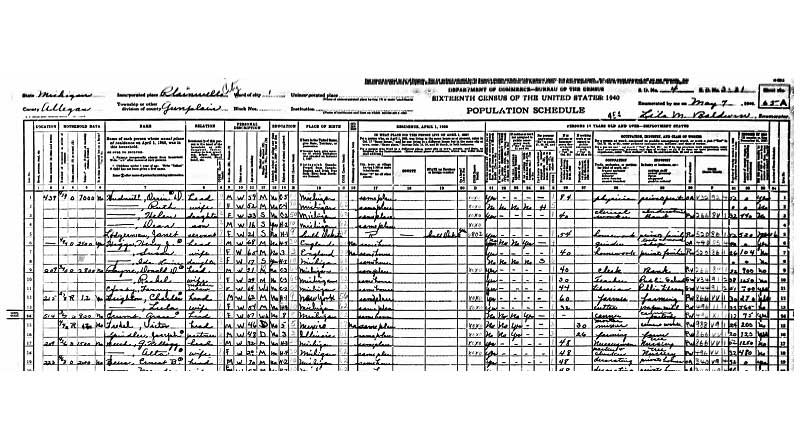The 2020 Census is Counting on You!
I think I first heard the word census during the summer of 1980, when I was in elementary school, and we spent our summer vacation researching our family tree on a cross-state road trip. I’m not sure I recall what it was or what it meant back then, but in recent years – as I’ve found a growing interest in my family history as well as the lives of others while researching for my writing, I have been finding more and more reason to access census data online.
Last month, I spent a few minutes filling out the online Census survey (nine questions, answered on my phone). It was the fourth time I’ve submitted my data (the first three times via mail) since I became an adult – the first time I would have “counted” was in 1970 when was not even one year old!
Just recently, I was contacted to serve as part of the U.S. census media outreach effort in West Michigan. How exciting! Now, instead of just using the census to research history I am a (minute) part of the team helping make history for future generations.
The first census was held in 1789, as mandated by the Constitution (Article 1, Section 2) which calls for the “enumeration” to be made of the populace every 10 years across the United States. That makes this the 24th time the nation has counted its population – and the first time everyone can respond online, by phone or by mail.
According to History.com, the concept of the census wasn’t unique to America.
“The ancient Babylonians, Chinese, Egyptians and Romans all conducted censuses, as did William the Conqueror, who in 1086 inscribed info about England’s landowners into the so-called Domesday Book. Censuses are even mentioned in the Bible. However, the Untied States was one of the first modern countries to count all of its citizens and not just, say, military-age males. It was also the first country to constitutionally mandate a regular census and the first to use the census for apportioning political power.”
That means participation in the census is required by law!
For years, I thought the census was just a list of people who lived in a numbered house, on a road in a city, with their family or boarders (at least, that’s what I’ve been seeing with my online searches) which genealogists use to build their family trees.
Turns out, the data collected serves much bigger purposes.
First of all, the results of the census determine the number of seats each state will have in the U.S. House of Representatives, and they are used to draw congressional and state legislative districts (something I should have learned in high school or college history classes, had I had any interest in such things back then).
The statistical data also helps local, state and federal lawmakers in the allocation of BILLIONS of dollars for dozens of sectors (healthcare, education, public safety, roads, fire departments, rural assistance programs, infrastructure and more), including but not limited to:
- Unemployment Insurance
- Low-Income Home Energy Assistance
- Supplemental Nutrition Assistance Program (SNAP)
- State Children’s Health Insurance Program (SHIP)
- Temporary Assistance for Needy Families
- School Breakfast Program
- Head Start, Nutrition Assistance and the Children’s Health Insurance Programs
- Special Supplemental Nutrition Program for Women, Infants and Children (WIC)
- Community Development Block Grant Entitlement Program
- Critical public services such as emergency response, hospitals and healthcare, water and waste disposal systems for rural communities
- Rural Business Development Grants and Rural Development Housing Preservation Grants
- Transportation services including maintenance and construction of roads and bridges through the Highway Planning and Construction Program
- Federal Transit Capital Investment Grants that can be used for Water Pollution Control Grants as well as public transportation
- Emergency Watershed Protection Program, Hazardous Waste Management State Program Support and the Wildlife Restoration Program
- Critical public services including hospitals, schools, roads and bridges, which in turn generate opportunities for private sector businesses
- Health clinics, senior citizen centers, home-delivered meals and job training for senior citizens
- Federal Pell Grants for college students
- Adult education grants
- Agriculture, science and engineering educational programs
- Programs focused on school safety, mental health services and student wellness
Think about it…when you take the time (and it seems we all have a lot more time these days) to respond to the census, you are helping shape the future of your community! You’re helping the single parent, the local farmer, the elderly neighbor, the college student, the veteran, the citizens in your city, township or county and so much more. Your information counts in ways that you may never now, but in ways that help our society on a daily basis.
Oh…and this data helps local and federal lawmakers determine how to allocate funds for the next 10 years for critical public services – including how to prepare for, respond to and rebuild after disasters and crisis (such as COVID-19), providing those in need access to things such as unemployment insurance, emergency food assistance, shelter grants and other temporary assistance.
A reminder, all responses to the census are kept confidential and are used only to produce statistics. By law, responses cannot be shared with law enforcement or immigration agencies. “According to the ‘72-Year Rule,’ the National Archives releases census records to the general public 72 years after Census Day.” That means that in April 2022, records from 1950 will be released and that 2020 data will not be released until 2092 (long after I and nearly everyone reading this are long gone).
For more information, visit www.2020census.gov.

